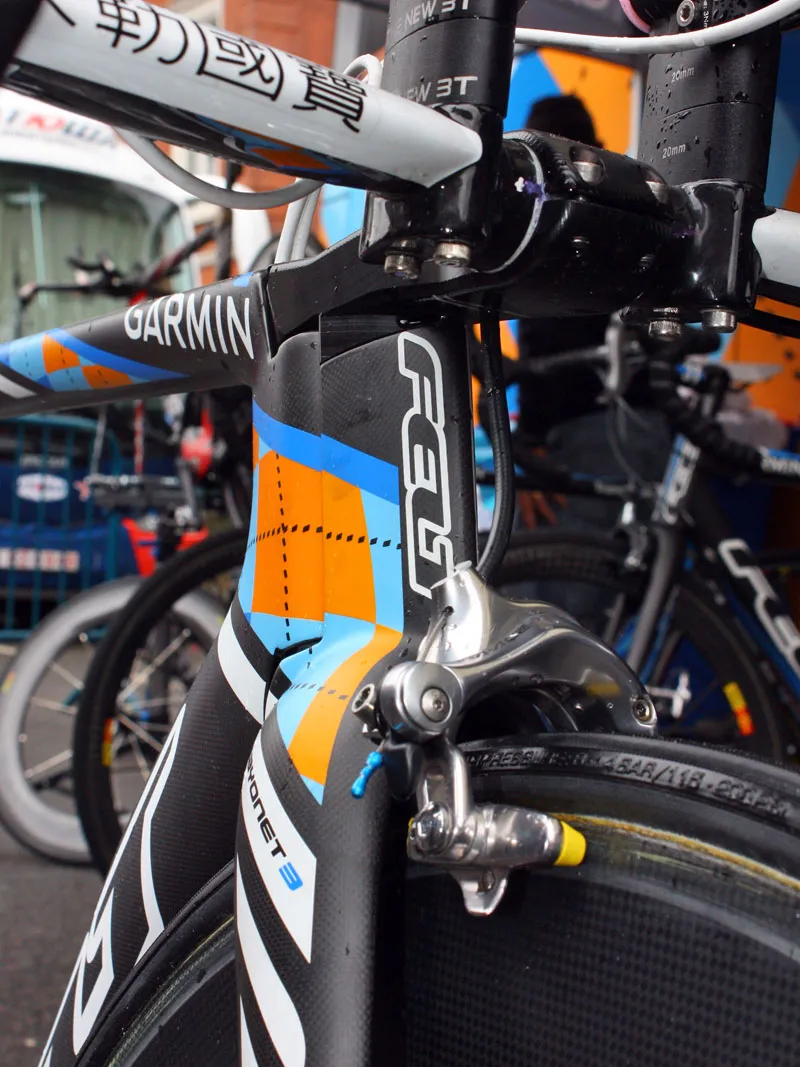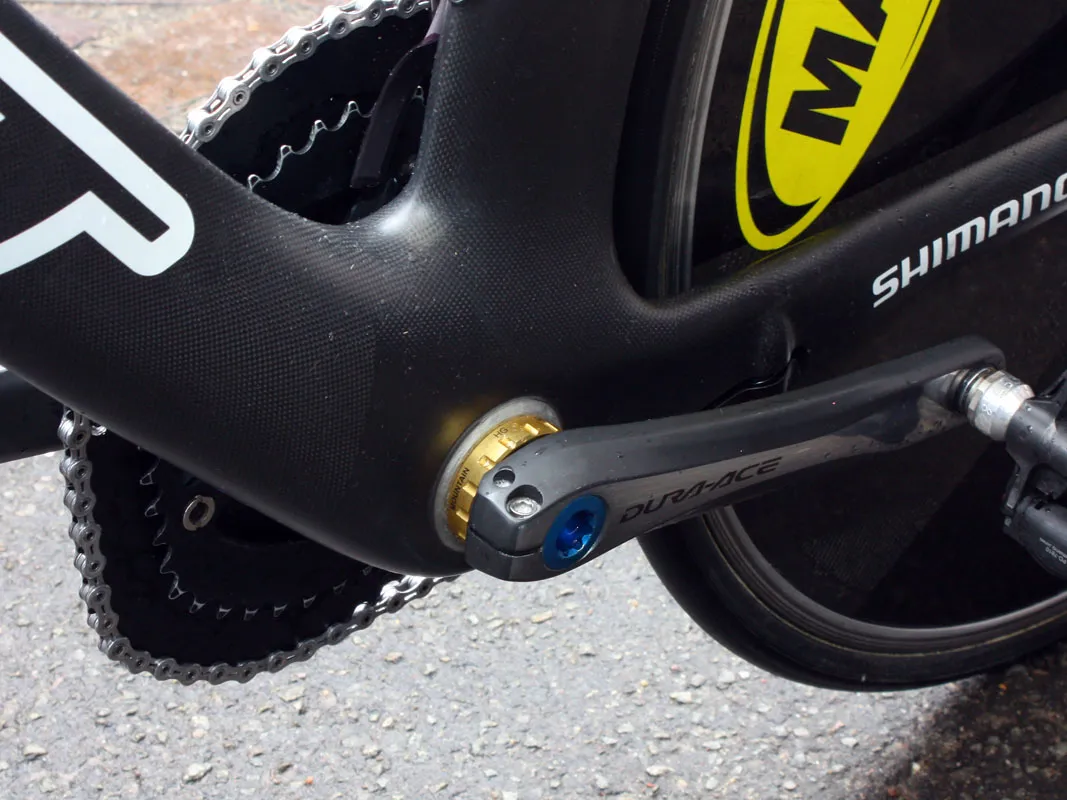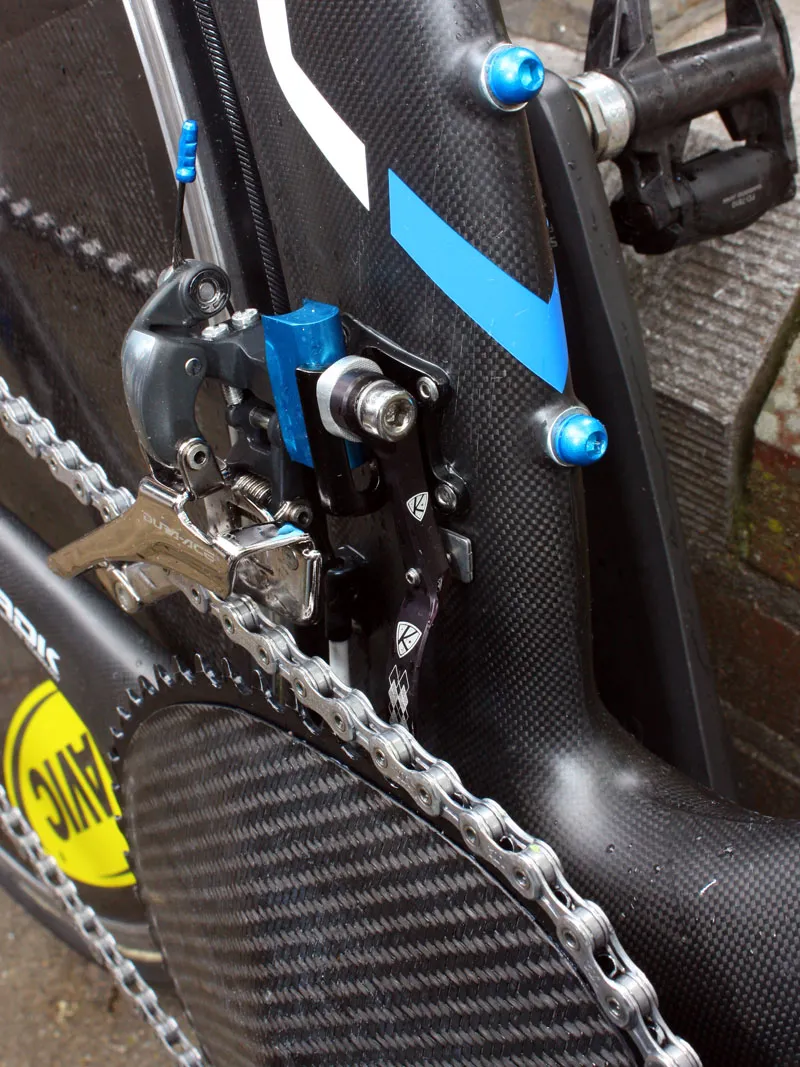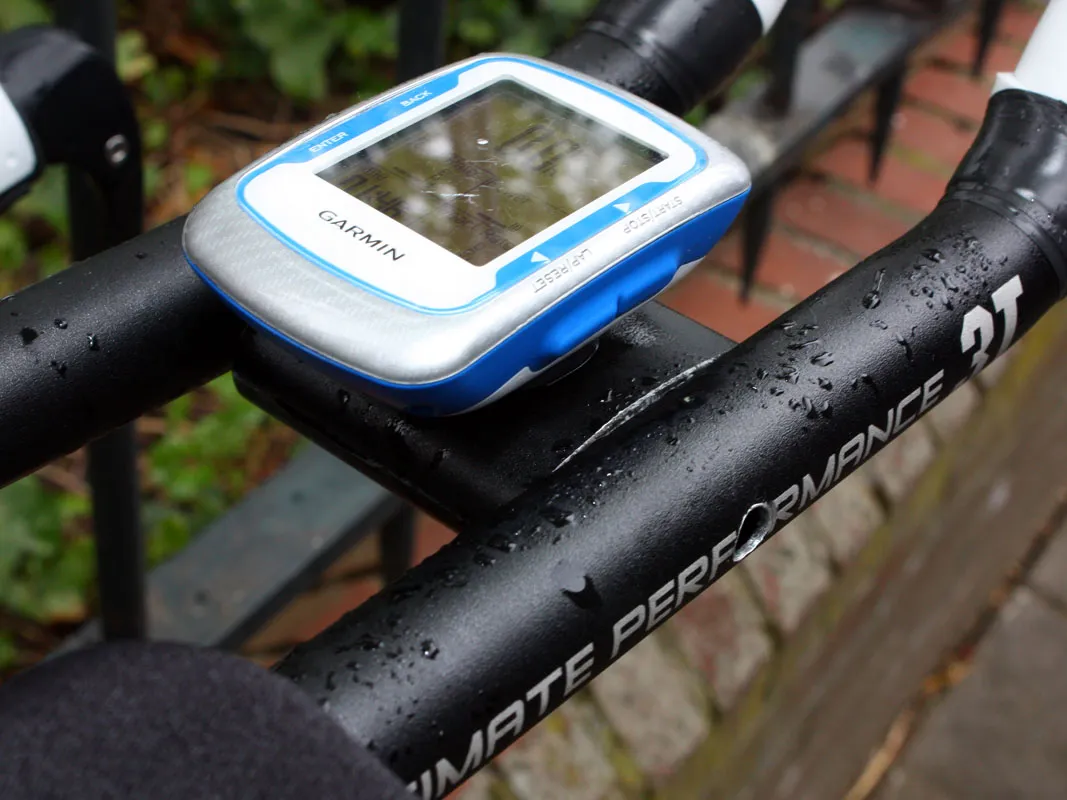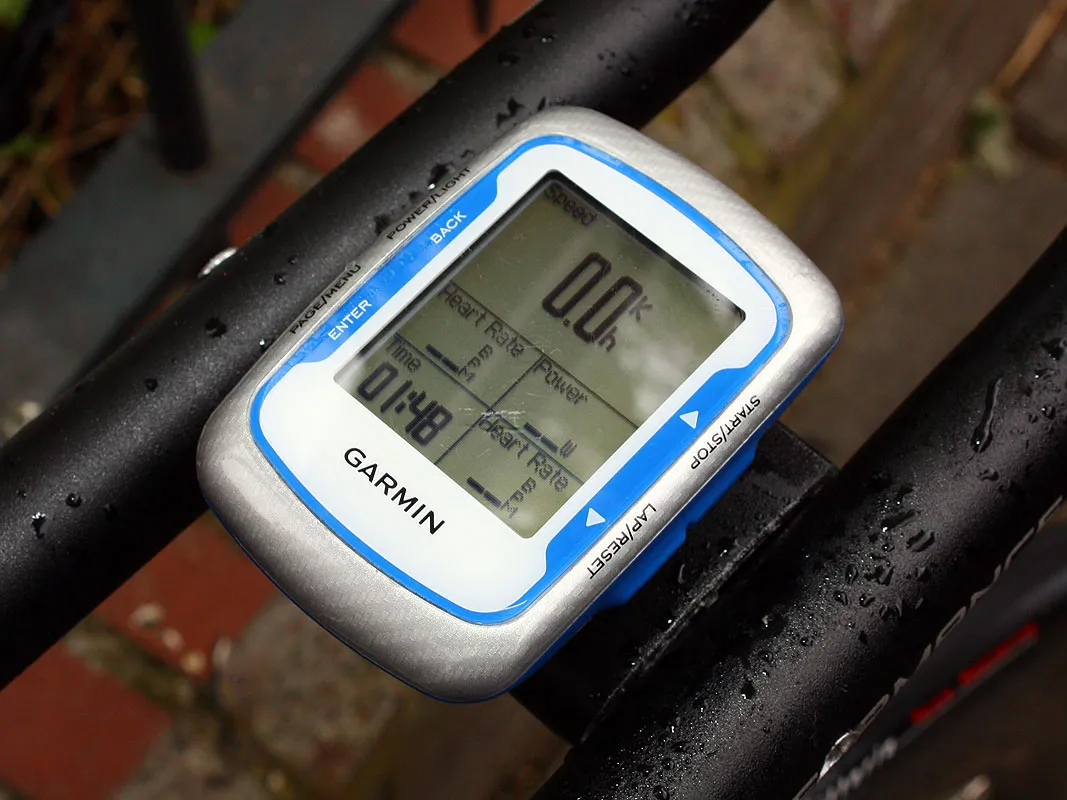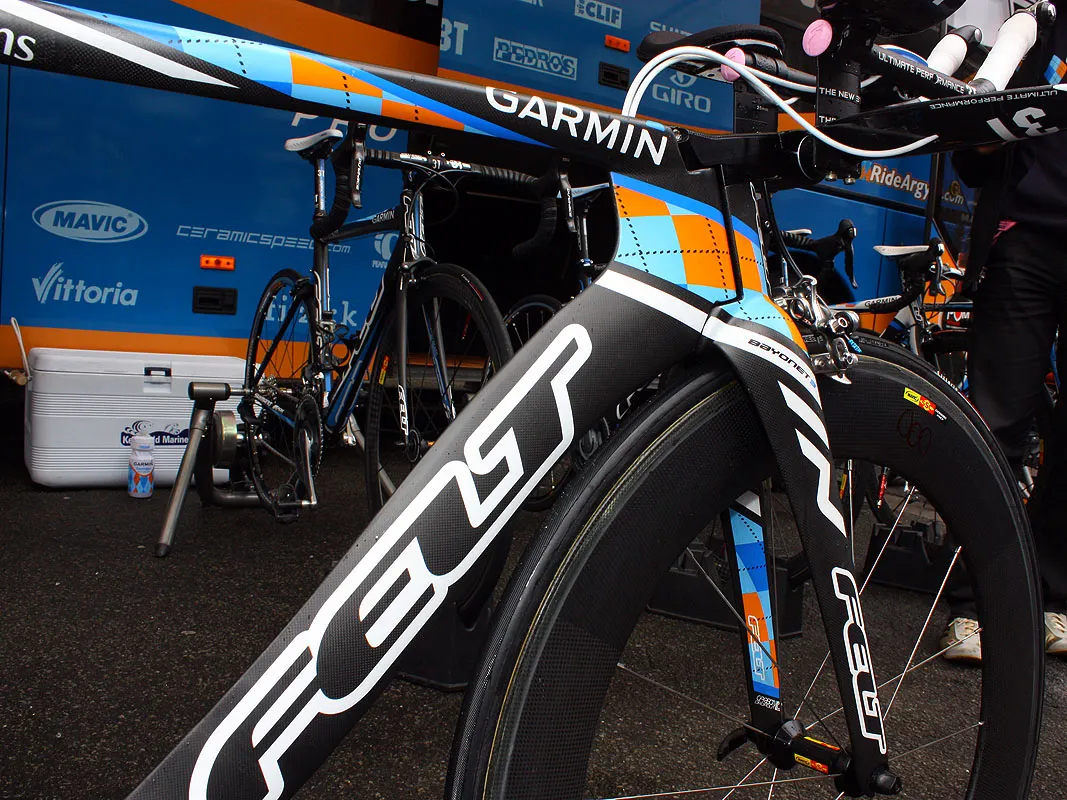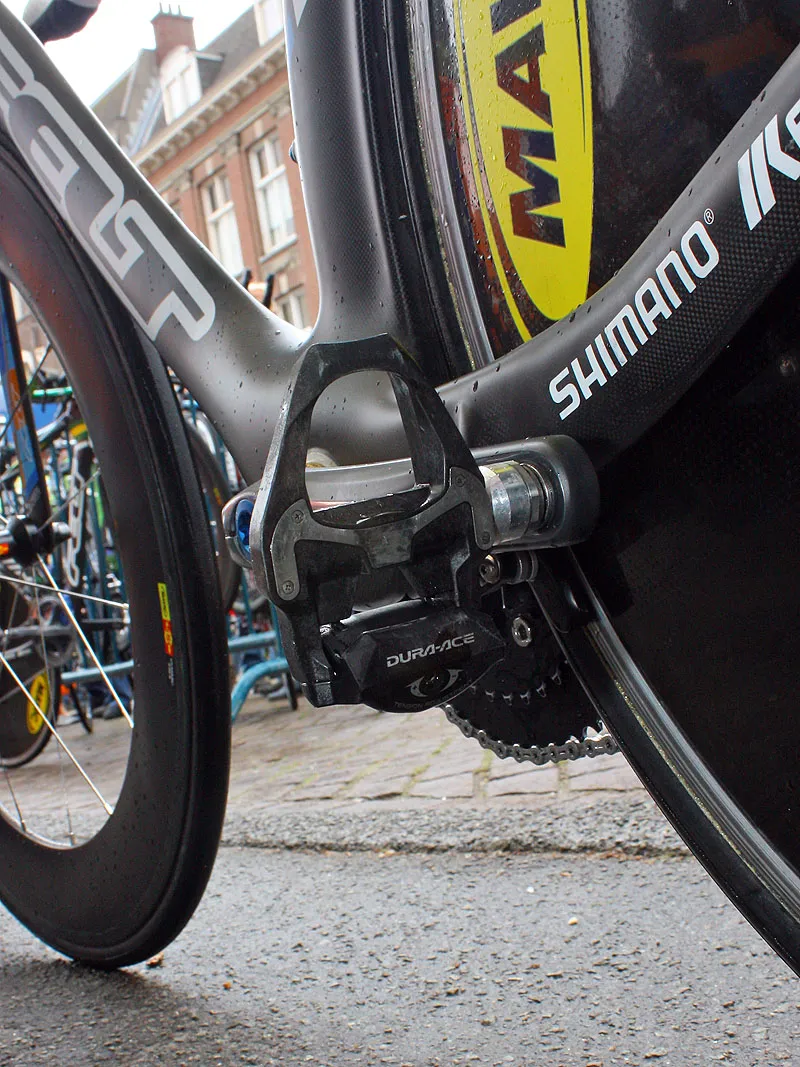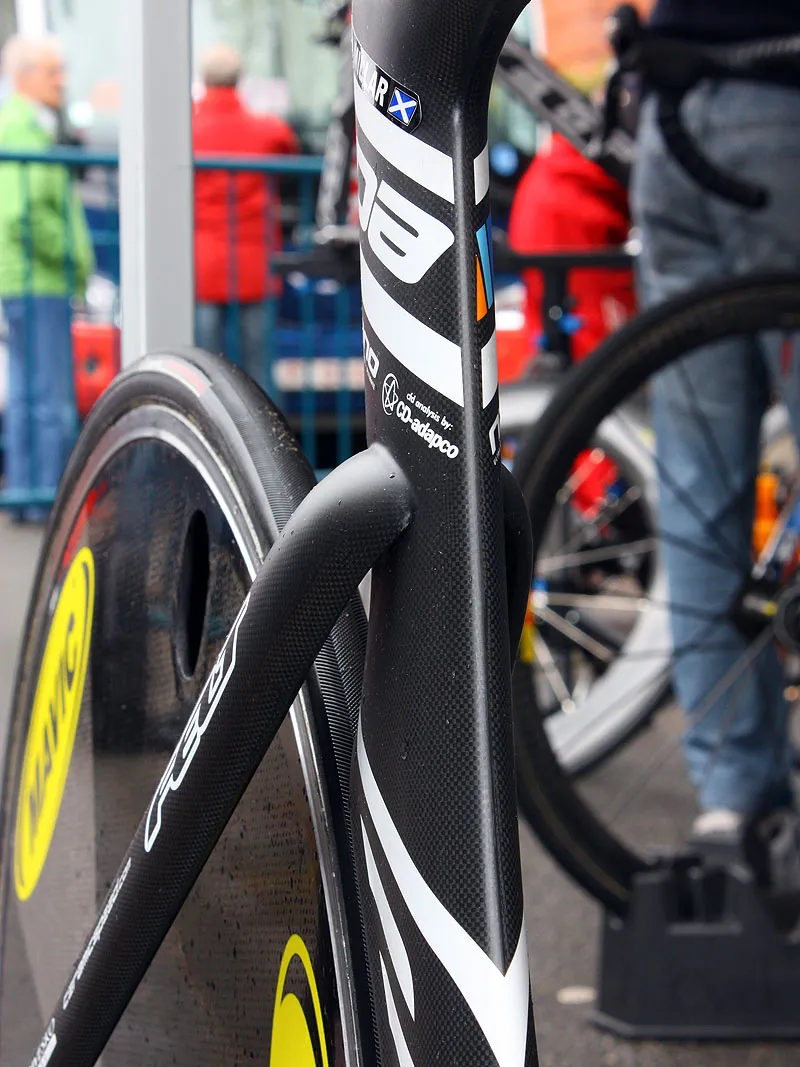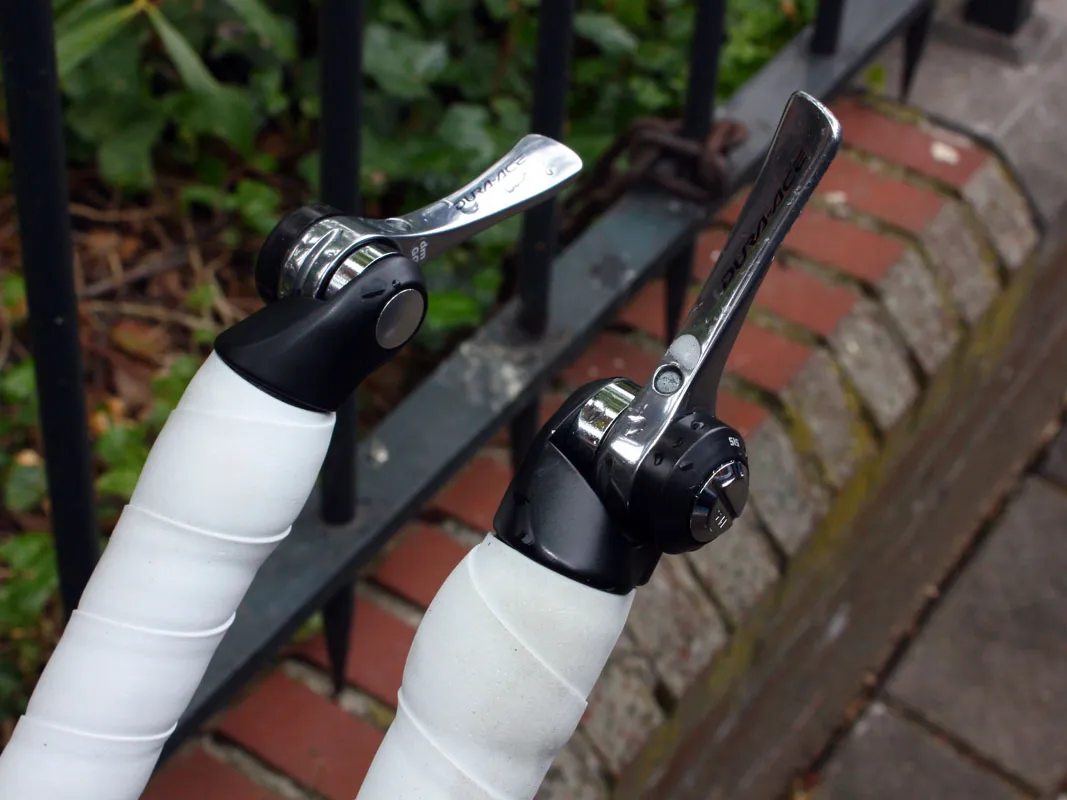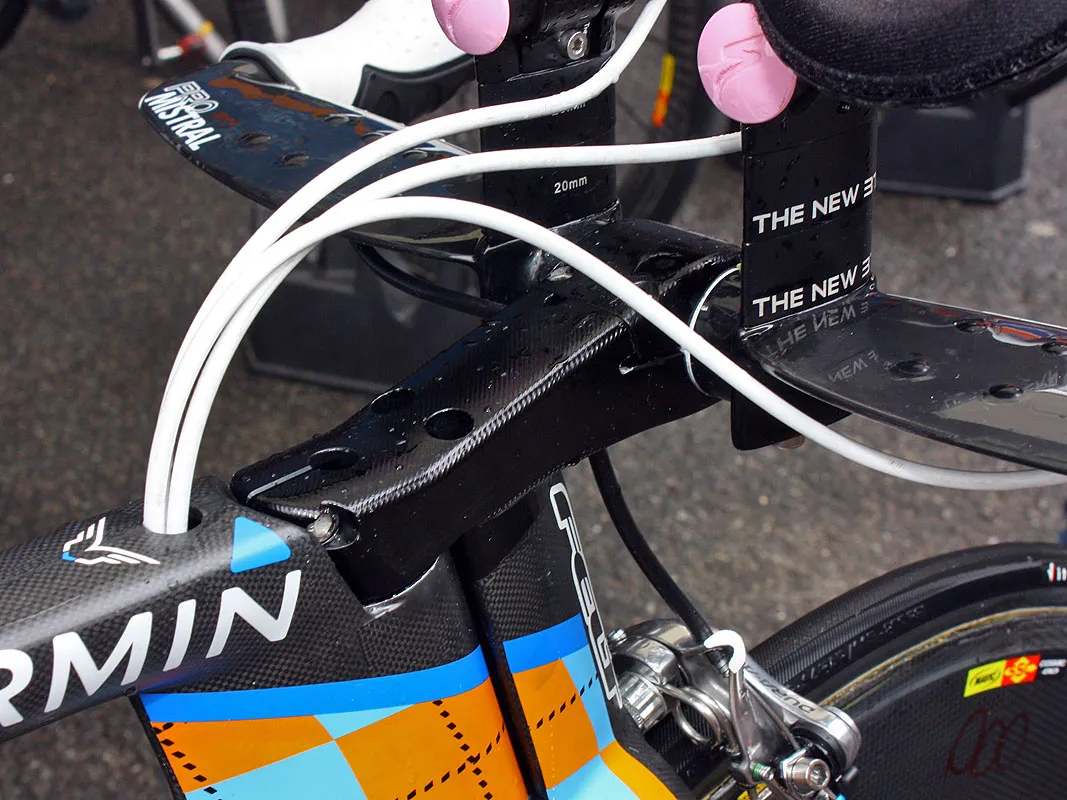Garmin-Transitions time trial specialist David Millar debuted an all-new machine at this year's Giro d'Italia opening stage from team sponsor Felt Bicycles. Though it wears the same DA model name, the new version's refined shape is sleeker and stiffer, and offers a more aggressive rider position than before.
Frontal area on this latest DA is claimed to be roughly half that of the 2007 version, aided in no small part by the third generation of Felt's distinctive fork, logically called the Bayonet 3. In contrast to the tapered and oversized headsets that have virtually become standard fare on road bikes, the Bayonet rotates on bearings with an inner diameter of just 19mm – about 6-10mm smaller than usual.
As before, the external steerer tube pairs with the teardrop-shaped head tube behind it to produce a more aerodynamic combination than a single structure would under current UCI rules, while also making for a stiffer front end for better handling.
Felt has taken some height out of the Bayonet 3, though, and topped it with a svelte, fixed-position stem that sits nearly inline with the top tube and more easily allows for a far lower position than before. This was a major issue with the old version, at least as far as the team was concerned, especially when they switched bar sponsors from Oval Concepts to 3T.
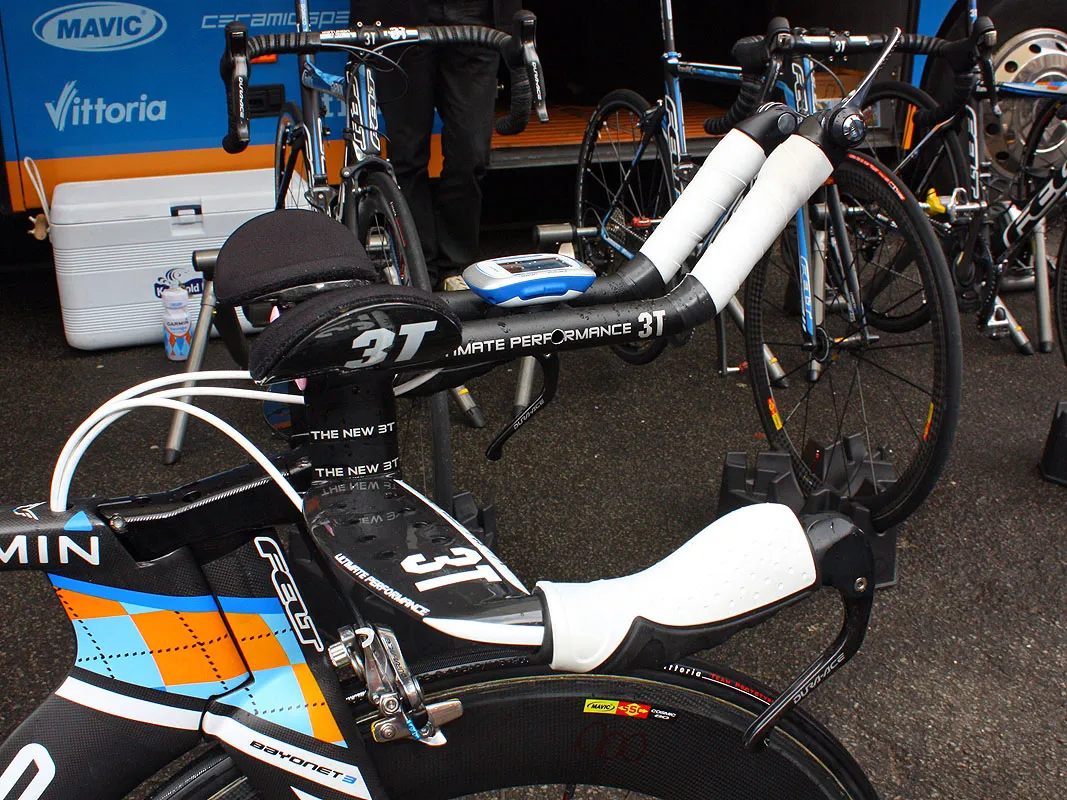
The new Felt DA has a lower inline stem but Millar likes to be up high on the extensions
The fork blades have been reshaped, too, with a more gradually tapered form that omits the previous version's rearward extensions down by the dropouts.
Also adopting a simplified shape is the new down tube, which skips the old DA's slight scallop around the front wheel with a more gently curving shape. This still provides nearly the same amount of coverage, just by starting out lower behind the fork crown. The overall dimensions have grown, too, helping to yield a stouter front triangle that team mechanic Kris Withington says Millar praises as being "way stiffer" underfoot for notably better pedaling efficiency and steering precision.
The top tube is level as before but it, too, has grown slightly, further contributing to the frame's improved rigidity and more confident feel.
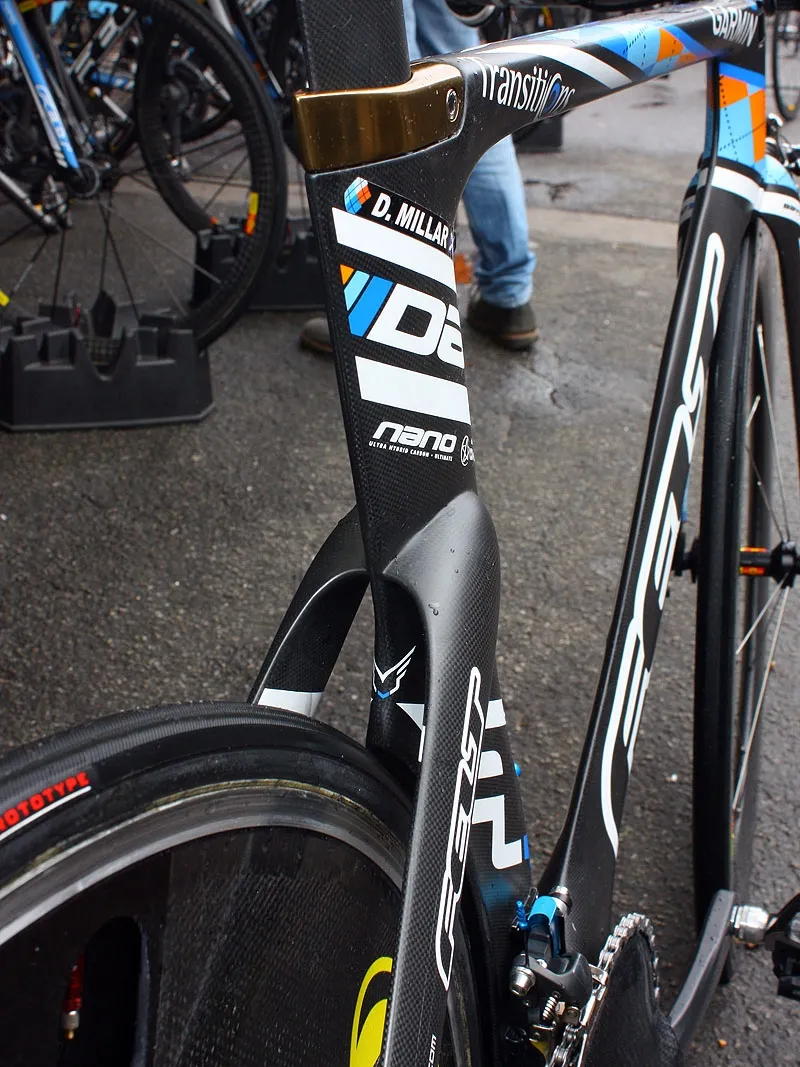
A revised seat stay position to allow air to flow more freely around the wheel
The seat tube still closely follows the rear wheel as before but is now deeper throughout its length – again, likely contributing to overall stiffness – and terminates up top in a telescoping aero-profiled carbon seatpost that includes a dedicated mount up top for a Shimano Dura-Ace Di2 battery. Down below is a newly BB30-compatible bottom bracket shell (fitted with a press-fit threaded sleeve for use with the team's Shimano cranksets).
Further back, the seat stay junction has opened up significantly, likely allowing more air to cleanly pass through and around than the old design, while the stays themselves have grown in depth and thickness. Chain stays have similarly been enlarged, but lying beneath them is one of the new DA's cleverest tricks.
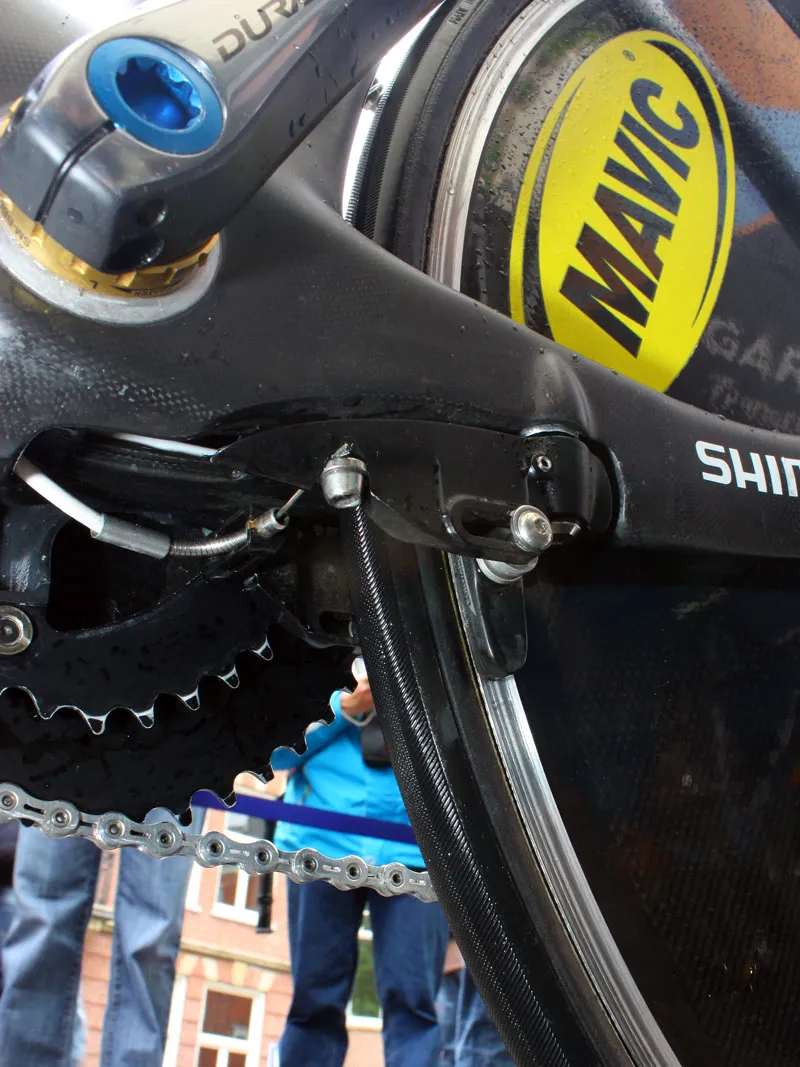
The rear brake is now bottom mounted
Felt has moved the rear brake from atop the chain stays to below them, using a proprietary linear pull-type design that sits virtually flush with the surrounding frame surface. In addition to presumably being more aerodynamic, its brutally simple design may even shed some weight, too, and yet it still looks reasonably accessible for pad and cable tension adjustments.
Built into the new carbon rear-entry horizontal dropouts are integrated adjusters and the cable routing has been further refined to retain smoother exterior lines. According to Withington, the team is currently working with Felt to develop a fully internal setup (including through the bar and stem) for running a Di2 wiring harness.

13T/15T pulleys for reduced drivetrain friction
Millar's build kit is especially noteworthy with a heavily modified Shimano Dura-Ace group. Longer and straighter down tube shifters have been adapted for bar end use and the 7800 rear derailleur has been adapted with a Berner carbon fibre cage and oversized (13T upper, 15T lower) pulley assembly for reduced drivetrain friction.
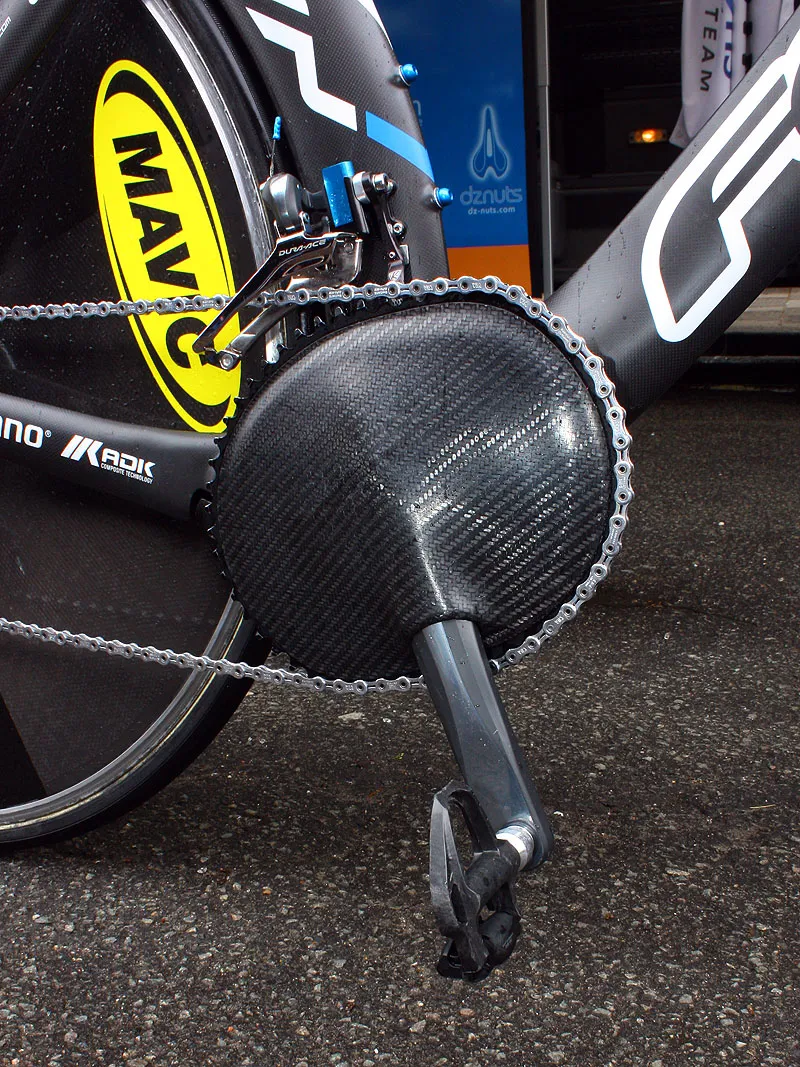
O.symetric chainrings up front. Carbon fibre leg of ham, anyone?
Further up, the 7800 front brake calliper has been chopped and drilled to make for a more centrally located housing position, O.symetric chainrings and an aerodynamic carbon cap are bolted to a set of 7900 crankarms, a spacer is inserted between the mounting tab and 7900 front derailleur to make it all work, and if all else fails, there's an AceCo K-Edge chain watcher installed as extra insurance.
About the only things that have been untouched are the stock Dura-Ace 7900 chain and cassette and prototype carbon-bodied SPD-SL pedals.
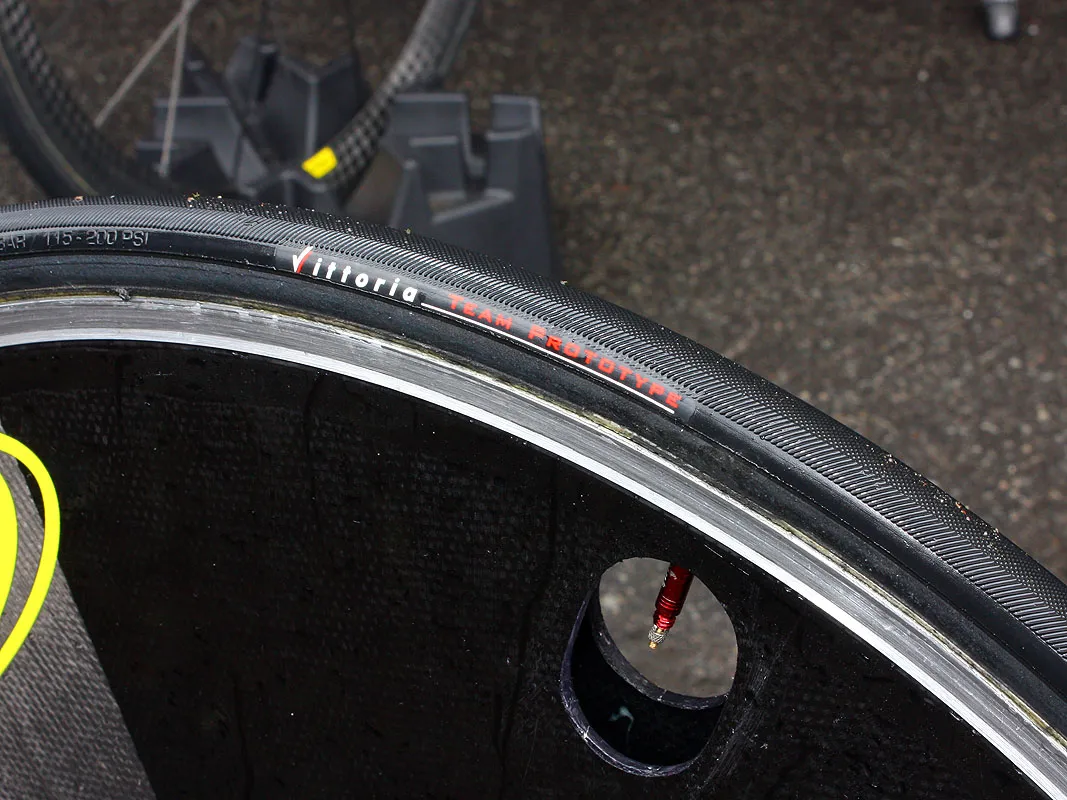
Millar is running a prototype Vittoria tubular on the rear
Rolling stock consists of a Mavic Comete rear disc with a bonded-on aluminium tubular tire bed matched to Mavic's latest 80mm-deep Cosmic 80 front carbon tubular. On the day of our photo shoot, Millar was using a Vittoria Corsa EVO CX tubular tyre out front but a prototype Vittoria tyre on the rear.
Total weight for the slippery rig was 8.72kg (19.22lb) as pictured, complete with a Garmin Edge 500 GPS-enabled computer.
Complete bike specifications
- Frame: Felt DA prototype, size 54cm
- Fork: Felt Bayonet 3
- Headset: Felt integrated
- Stem: Felt Bayonet 3 integrated, 100mm
- Handlebars: 3T Mistral Pro, 42cm (c-c)
- Tape/grips: 3T
- Front brake: Shimano Dura-Ace BR-7800 (modified) w/ SwissStop Yellow King pads
- Rear brake: Felt DA integrated
- Brake levers: Shimano Dura-Ace BL-TT79
- Front derailleur: Shimano Dura-Ace FD-7900-F
- Rear derailleur: Shimano Dura-Ace RD-7900-SS w/ Berner carbon fibre cage and 13/15T pulleys
- Shift levers: Shimano Dura-Ace SL-7900, modified for bar-end use
- Cassette: Shimano Dura-Ace CS-7900, 11-23T
- Chain: Shimano Dura-Ace CS-7900
- Crankset: Shimano Dura-Ace FC-7900, 180mm, w/ O.symetric chainrings and custom carbon fibre cap
- Bottom bracket: Shimano SM-BB80
- Pedals: Shimano Dura-Ace SPD-SL carbon prototype
- Front wheel: Mavic Cosmic Pro tubular
- Rear wheel: Mavic Comete
- Front tyre: Vittoria Corsa EVO CX tubular, 23mm
- Rear tyre: Vittoria prototype tubular
- Saddle: fi'zi:k Ares k:ium
- Seat post: Felt DA carbon
- Computer: Garmin Edge 500
Critical measurements
- Rider's height: 1.9m (6' 3")
- Rider's weight: 77kg (170lb)
- Saddle height, from BB (c-t): 807mm
- Saddle setback: 50mm
- Seat tube length, c-t: 540mm
- Tip of saddle nose to C of bars (next to stem): 620mm
- Saddle-to-bar drop (vertical): 170mm (to elbow pads); 250mm (to base bar grips)
- Head tube length: 90mm
- Top tube length: 545mm
- Total bicycle weight: 8.72kg (19.22lb)


